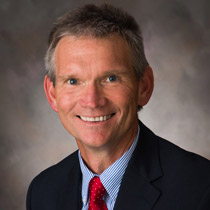
From Earth to Sky and Everything in Between
The School of Natural Resources serves the public through research, teaching and outreach
The School of Natural Resources at the University of Nebraska–Lincoln embraces the land-grant mission of teaching, research and extension. And according to its director, John Carroll, the school’s objective is to “assist society in managing the land and its resources in the best way we can.”
Carroll’s goal is for the school to be an international leader in natural resources education, research and outreach in its three core areas of Applied Ecology, Applied Climate and Spatial Science, and Environmental Science. Natural resources include everything from soils to water, ecosystems to biodiversity, and climate, too. Each of the resources is especially important in Nebraska, where so much of its land and economy is rooted in agriculture. This also means natural resources science is complex and includes challenges, such as feeding a growing population without damaging the environment, dealing with changes in climate, and solving society’s problems while protecting valued areas, animals and resources. Finding balance is key.
The impact of research conducted in the School of Natural Resources (SNR) includes the state, but also the region, nation and the world.
“We cut across so many different fields and disciplines and across important questions that are facing the world,” Carroll said. “We look at issues related to limited resources. We conduct research on water, soils and climate change — issues that affect everybody across the globe.” Much of the research is collaborative, which is made easier Interview with John Carroll By Emily Long FROM EARTH TO SKY AND EVERYTHING IN BETWEEN The School of Natural Resources serves the public through research, teaching and outreach. because the 80 SNR faculty members work in the same building on the university’s East Campus, he said; seeing one another regularly makes it more natural and convenient to work on projects together, and the outcomes have a larger impact.
“When you get different disciplines looking at overlapping questions from different perspectives, you can get really creative ideas on how to solve global problems,” Carroll said. “Solutions scale up from very localized to global in each of our areas of research focus.”
RESEARCH AND DATA
Carroll said natural resources scientists are quantitative by nature and have been accumulating research data by collecting soil and rock samples and recording measurements of water levels, water quality and climate variables across the state for more than 100 years. This includes scientists’ long history of research and data collection of the Ogallala Aquifer, which is part of the High Plains Aquifer System. The Ogallala Aquifer underlies most of Nebraska, providing water for the state’s crops, animals and people.
“I think our scientists’ monitoring of that system over decades has helped inform decision-makers – everyone from energy companies to farmers to city planners – so they can make better decisions about how we manage the aquifer,” Carroll said.
He added that with current technologies, SNR’s scientists are able to obtain “huge amounts” of geological data through remote-sensing methods that also can help monitor the complex aquifer. Remote-sensing data is collected not only from airplanes, but also from federally-operated satellites, unmanned aerial vehicles or drones, and sensors placed on and just above the ground.
The enormous amount of data generated through monitoring natural resources, from the Earth to the sky, must be stored in an accessible way, analyzed and explained, Carroll said. Increasingly able and effective computer and data generation systems make storage the easy part; the challenge is in interpreting the information so informed decisions and accurate predictions can be made. Yet, SNR scientists are able to project short-term and longterm temperatures and precipitation trends for individual towns and cities using scientifically sound models and historic data inputs.